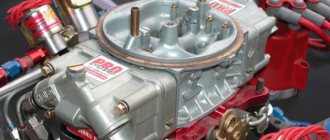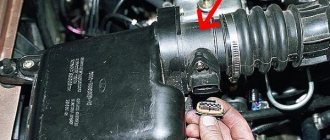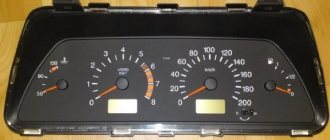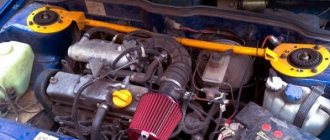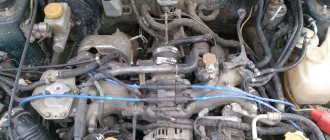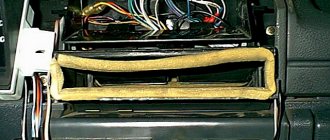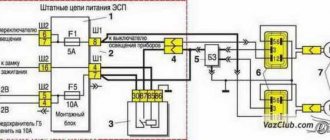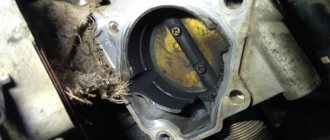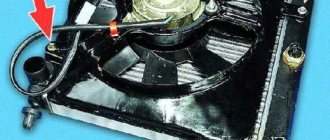VAZ 2114 is a restyled model of the well-known “ten” or “Samara”. This car became widely known, so this brand of five-door hatchback can be found on the roads today, despite the fact that this car was removed from the production line several years ago.
This car has an electronic engine control system. Many people know that an injector of this type often begins to behave unpredictably. This usually happens when going to idle. As a result, the revs “float”, and the car owner cannot understand what happened to his beloved vehicle.
It is very difficult to immediately determine why the VAZ 2114 injector stalls at idle. As a rule, this requires diagnostic measures, which are best performed at a service center. However, you can try to understand on your own why the car stopped working as it should. Therefore, it is worth listening to the opinions of professionals who have encountered such malfunctions.
Regulator XX
This is one of the fairly common reasons why the VAZ 2114 injector stalls at idle. Regulators called XX or IXX are special devices that help control engine speed at idle. For the power unit to function properly, some air must pass inside. It, in turn, is detected by the mass air flow sensor, and the fuel controller supplies fuel based on sensor readings. Also, the number of revolutions is controlled by the DPKV. But it is the XX regulator that is responsible for the air supply, regardless of the operation of the air valve.
If an IAC system is installed in the car, then, as a rule, the car owner does not need to warm up the engine for a long time before starting to drive. However, this type of regulator is not capable of self-diagnosis. Therefore, if it fails, the VDO VAZ 2114 dashboard does not notify the driver that this unit needs to be checked.
Poor starting on a hot VAZ 2114
The VAZ 2115 starts ideally in the cold and when starting hot. stops immediately. After cooling it starts without problems. What could be the reason?
Bad hot
launch. one of the diseases of VAZ cars. Therefore, the question is very common. This is due to the low quality of spare parts and some design features. It happens that the fuel pump is replaced with a new one, but it turns out to be faulty. In "troubleshooting" things change and the problem is discovered in the second round.
If the device does not start hot, we recommend checking the following algorithm:
Topic for beginners. Make sure that the problem is related to the hot condition of the car. Check the battery charge, make sure that the alternator is charging (with a multimeter in voltmeter mode). Are there problems with the starter? If it turns, it doesn’t, or sometimes it turns poorly. take it to an electrician. For everyone else. It is advisable to start repairs with diagnostics. this will help you save money. Approximately 80% of the causes of the problem will be revealed by the diagnostician, the faulty part will be replaced and the car will drive away, and you're welcome.
The rest of the information is for the remaining 20% (diagnostics does not reveal problems) and those who do not have qualified specialists in the access area.
26 comments on “The VAZ 2114 car does not start when hot, but when driving everything is fine”
Ignition module! Try shooting it hot and cool.
I also had the same bullshit that the tags got confused over time
Look at the crankshaft sensor
Possibly the ignition switch.
READ Changing the Oil in a Ford Explorer 5 Box
try putting a cold cloth on it
So the fuel pressure
The sleeve (copper) in the bell is already broken and the starter stupidly bites (when it’s hot). This is only if everything is fine in the cold.
Antokha, it’s okay to start cold
Are the injectors clogged? try draining the fuel from the ramp and get to work
Measure the pressure in km, see Conditions
Miras, this is your 100% addiction. This happened to four last summer. Until it cools down a bit, does it start correctly? If you change it, it costs about 500 rubles. This is the reason
I had the same thing, only the reason was the fuel pump, I replaced it and everything is fine
Pennies are glued to the retractor, removed and cleaned, or a new retractor!
Andrey, that’s right, what kind of picture can I send?
Miras, here it is, I couldn’t take it off. There seems to be no way out without removing the starter itself. I poked for an hour and a half, went to work
Here with the starting ipos... First of all, understand, look, you shouldn’t change everything because of this.
what kind of starter do you have starter speed
the fuel pump does not create the required pressure, it seems to be checking
Crankshaft sensor see
Battery. It was exactly the same bullshit. I spent 2 months looking for the problem, they replaced everything, but it turned out to be the battery. I changed the battery and everything is fine
Where does a child's stimulating brain come from? The starter turns the engine, you can hear it perfectly
It's a shame that girls are smarter than boys. But aren't you ashamed?
see tags. the belt sound disappeared
Look at the sensor on the thermostat, this is the temperature, but it is also responsible for the rich and lean mixture of fuel, I suffered for a long time and for the first time changed 3 pieces (enough of the defects), I thought I could grab it from the sound, this is the sensor. if the belt fell, the sound would be different, because some valves are open, the starter would spin more easily, as if there were no compression. To check, try removing the chip from the sensor while it is hot and turn on the starter longer, it will start.
Too rich or lean mixture - air flow sensor
We mentioned above that problems with starting the car can arise due to a malfunction of the mass air flow sensor. mass air flow sensor. This element of the car is one of the most vulnerable to the environment, which is why they often talk about its breakdown. If it is very difficult to start the engine when hot, check the operation of this mechanism. This failure may also be accompanied by the following factors:
breakdown when pressing the accelerator pedal, lack of traction at certain moments; reduction in power or vice versa. an inexplicable increase in the potential of the unit; difficulty starting the engine and periodic moments of deformation; explosions inside the exhaust system when the accelerator pedal is sharply pressed; unstable speed due to periodic changes in mixture enrichment.
The fuel mixture of gasoline and air must have a certain consistency, which is formed by the mass air flow sensors and several other parts of your vehicle's electrical and electronic system. If these defects are faulty, you will have to change them and test the car, get the new equipment working.
Self-diagnosis of ICC
To understand that this particular unit is the cause of a stalled engine, it is enough to pay attention to several signs:
- The car's power unit stops working as soon as one of the gears is turned off.
- The revolutions begin to “float”.
- When XX is activated, the motor begins to malfunction.
- As soon as the car owner starts the engine when it is cold, it becomes impossible to increase the speed.
- When the driver turns on the headlights or other light optics, the engine speed begins to drop noticeably.
VESKO-TRANS.RU
VAZ-2114 does not start? no it starts
VAZ-2114 (injector)
Whoever has dreamed of owning a car has at least once found themselves in circumstances where, after intensive and diligent attempts to turn the ignition key, the engine simply refused to start. This happens often. Experts say that normal starting occurs after 2-3 attempts (the so-called smallest) of turning the key. But if the machine does not feed “signs of life” even in 10 attempts, this may indicate any difficult dilemma. In this article we will look at the reasons why a car may not start (injector / carburetor VAZ-2114) and how to solve this problem in a very short period of time.
Battery problems
In most cases, the main reason for an unpleasant start of a Russian (and not only) car is a low battery level. If the ignition key does not turn off, the built-in power supply may be disconnected from the battery. The only way to remove the obstacle. This is to check the terminals and, if necessary, charge the battery (the indicator should be greenish). When, a dead battery also indicates a “dead” starting staff (later VAZ- 2114
doesn't start at all). When you tried to start the car, you didn't hear the starter turning over, in which case lights appeared on the dash panel, then it obviously required a battery.
How to charge the battery in the absence of a 220V network?
If there is no charger nearby, otherwise there is no suitable outlet, try starting the car. "push" or light from another car, as shown in the photo below.
In the latter case, try starting the engine using the starter handle. But despite this, it is a more balanced option. put the battery on charge.
The starter is not working properly and the battery is low. What should I do?
's the way it is
Try starting the engine with the starter for 10 seconds and take a break for 5-6 minutes. After this time, the battery will recover slightly and a small amount of fat will enter the engine. After a short break, try restarting the machine. When starting the engine, be sure to check the charging current and ICE grounds.
How to fix the situation
There are several manipulations that will help solve the problem that the VAZ 2114 injector stalls at idle if the IAC is the cause. First of all, you need to disconnect the control unit from the power supply and disconnect the terminal. After this, you need to pay attention to the distance between the flange needles (or rather, their ends) and the regulator. There should be about 2.3 mm between them.
In the next step, the battery terminals are put back into place. After this, you need to turn on the motor for 10 seconds. In this case, automatic calibration of the IAC should occur. If everything is in order, then after this the engine will start normally.
However, this is not the only reason that the VAZ 2114 starts up when cold and stalls almost immediately, or speed jumps occur.
Crankshaft position sensor
When the sensor fails, the speed on a cold engine fluctuates, and the operation of the motor as a whole is disrupted. The computer is not synchronized with the engine, which disrupts the supply of spark and fuel. If the speed starts to fluctuate, this is only the first sign of a malfunction.
You can only check the operation of the sensor using a multimeter, for this:
- Set the tester to a position with a maximum value of 200 mV;
- Connect the tester;
- Close the core with a screwdriver.
The readings of the device should be in the range from 550 to 750 Ohms. If any discrepancies are found, try cleaning the core and repeating the procedure; this may be the cause of the breakdown. Otherwise, only replacement.
Cleaning the throttle body
First you need to disconnect the clamps that secure the hoses going to the remote control. You will also need to remove the pads from several sensors, or rather, the IAC (if any) and the TPS. After this you need:
- Remove the accelerator cable.
- Remove the throttle assembly itself and assess its condition visually. Such self-diagnosis will help you understand whether the VAZ 2114 injector really stalls at idle due to remote control.
- Disconnect the IAC, which is located inside the throttle.
- Assess whether there is accumulated carbon deposits under the sensor. If it is not in the chamber itself, this does not mean that it is also clean under the regulator. As a rule, all cars with decent mileage accumulate a lot of carbon deposits.
- Clean the IAC needle using a specialized aerosol. You need to process all parts very carefully, and then wipe them dry with a clean cloth. You must act with extreme caution so as not to damage anything. Therefore, it is better if you have a compressor at hand.
If the Lada Samara has low mileage or the sensor has recently been cleaned, then problems may lie in other parts.
Troubleshooting
To more accurately determine the malfunction, it is first recommended to carry out a full diagnosis. If you don’t have the time or money to take your car to a service station, we recommend using a personal ODBII scanner. In our case, it will be a Korean-made model Scan Tool Pro Black Edition
.
This scanner operates on a 32-bit chip (analogues in the budget segment have an 8-bit controller) and is assembled only from high-quality components, thanks to which it is capable of diagnosing not only the engine, but also other components of the car.
In most cases, the main cause of high speed will be a dirty air filter, a malfunction of the throttle position sensor, idle speed sensor or mass air flow sensor. In addition to detecting errors for more detailed diagnostics, Scan Tool Pro is able to monitor the performance of all available sensors in real time, which will help you quickly determine the exact cause of the malfunction.
Air filter
The first thing you should check when you notice high engine speeds at idle in a VAZ 2114 is the air filter. When it becomes dirty, it begins to pass air poorly, as a result of which the working mixture entering the engine becomes over-enriched and causes an increase in speed. To get rid of this problem, simply replace the filter with a new one.
Air filter VAZ 2114
Throttle position sensor
If this does not help, then you should move on to checking the sensors, namely the throttle position sensor, since it most often fails. To do this, you need to measure the voltage at its contacts at idle speed (the voltage value should be close to zero).
Throttle position sensor VAZ-2114
If it turns out that voltage close to normal in the on-board network constantly passes through the sensor, it means that acidification has occurred in it, and cleaning should be performed.
To do this you need:
- Disconnect the wires from the sensor terminals.
- Unscrew the pair of mounting screws holding its body.
- Fill the internal cavity with WD-40 or a similar penetrating lubricant.
- Turn the sensor wheel using a screwdriver or thin blade.
- Reinstall the device.
Idle speed sensor
If the reason was precisely the gas sensor, then the idle speed should immediately return to normal. If this does not happen, then you should proceed to cleaning the idle speed sensor (since it also often oxidizes and fails).
Idle speed sensor VAZ 2114
This operation is performed as follows:
- Disconnect the wiring and dismantle the device by unscrewing the mounting screws (the sensor itself is located not far from the throttle valve, opposite its cable).
- Connect the wires to the device and turn on the ignition. If the moving needle of the sensor moves slightly inside the housing, then it is working; if not, the sensor is soured and requires cleaning.
- Wipe the entire surface of the sensor with WD-40 or purified gasoline, removing all traces of oxides, oil and other contaminants.
- Mount the sensor in place, start the engine and check its operation.
If after cleaning it turns out that the speed is still too high and the sensor does not work normally, then it should be replaced with a new one of a similar model.
Mass air flow sensor
In the case when all the previous operations did not help, and the VAZ 2114 still has high idle speeds, you should check the mass air flow sensor.
This is quite simple to do - you just need to disconnect the wires coming to it, then start the car and drive it for some distance at a crankshaft speed of more than 2,000 per minute. If at the same time it “feels” like the car has begun to behave more dynamically than a car with a connected sensor, then the cause of the malfunction will become more than obvious.
DMRV VAZ 2114
To eliminate it, you will need to dismantle the sensor and replace it with a new one, since, unlike previous sensors, this one is practically irreparable.
It is replaced like this:
- Disconnect the wires leading to the contacts of the air flow sensor.
- Loosen the hose clamp on the inlet pipe.
- Remove the hose from the pipe.
- Remove the damaged sensor.
- Install a new device by performing all operations in reverse order.
To check the effectiveness of the repair, just start the engine and look at the idle speed - if they return to normal, then the problem is solved.
Air filter
If all the reasons described above do not apply, then you should pay attention to the filtration system. This unit also often leads to malfunctions.
On injection-type cars, filters are adjusted to an optimal and universal operating mode. This element is necessary in order to trap dust and dirt, but not impede the passage of clean air. Typically, small panel filters are installed in VAZs. They are considered more efficient and compact. However, cylindrical models are often installed in cars, which quite quickly cease to perform the task correctly. In this case, you will need a simple diagnosis of the VAZ 2114 car and replacement of the damaged element.
Vibration at idle. At gunpoint - ignition
One of the main reasons for vibration at idle in an injection engine is incorrect operation of the ignition system.
Even in the case when the fuel-air mixture is supplied to the cylinder in the required quantity and on time, the passage of a spark, constant or periodic, will certainly lead to vibration. Moreover, at medium and high speeds the engine can operate stably, with nominal fuel consumption and good dynamics.
First of all, we check this:
Any gaps in spark formation will lead to uneven emission of exhaust gases; you can check this simply by placing your hand near the exhaust pipe of the muffler; the gaps will be immediately audible.
A good engine should have uniform exhaust
Breakdown in the high-voltage circuit. Initially, it is worth checking the high-voltage wires - they should not contact ground, both along the entire length and in places of contact with the coil and spark plug cap
Breakdown of high-voltage wires can cause engine vibration
Candles. Quite often they can malfunction at low speeds due to a breakdown in the housing. In this case, a dark brown or black coating will be clearly visible along the rim of the insulator from below - the first sign that the spark plug is breaking through to ground. You need to check each spark plug - while idling, you need to remove the caps one by one and listen to see if the engine operation has changed. Faulty spark plugs must be replaced (see “selection of spark plugs for the VAZ-2114 - parameters and clearances”).
We check the spark plugs by removing the caps one by one
Malfunction of the ignition coil (ignition module). In this case, you can check the functionality only by replacing the module or coil with a known working one.
Changing the ignition module
In addition to these problems, difficulties may arise in the operation of electronics; this mainly applies to injection engines. And only these were installed on the VAZ-2114, with the exception of the Samar-2 line being the VAZ-2115 - there were carburetor versions.
Repair
For self-diagnosis and repair, the air filter must be removed. It is not so difficult to do this on injection-type cars. To do this, you need to open the hood of the Lada Samara and disconnect the DRV.
After this, all that remains is to find the screws (usually there are four of them) that secure the filter and remove them using a shaped screwdriver. After this, you can easily remove the filter. At the next stage, all that remains is to assess how dirty it is and, if necessary, replace this element.
Other breakdowns that cause interior vibration
But it’s not for nothing that the list of possible faults includes the item “Other technical flaws”. Just because some problems are more common than others doesn't mean they don't happen. That is why it is better to carry out a full diagnosis of the car when vibrations occur in the cabin.
Burnt-out diodes, pebbles and plants getting stuck in parts, friction of parts against each other, tilting of the engine and dents on the body - these are just a small part of those minor faults that can cause unpleasant trembling of the body and disrupt the operation of the engine. Fixing them doesn't take much time if you know how to do it yourself. A car service would not be the best solution. Once mechanics become aware of annoying vibrations, they may force you to replace already functioning parts.
Having bought a car, you should be prepared for the fact that you will have to learn how to understand it if you do not want to leave huge sums of money in car repair shops. This is especially true for VAZ, which likes to annoy drivers with all sorts of breakdowns, from slowly working wipers to body vibrations. You must always carefully monitor your vehicle if you do not want to stop in the middle of a busy road and cause a lot of inconvenience to others.
Fuel filter
This element acts as a fuel purifier that enters the engine. If the fuel mixture contains a large amount of dirt, various impurities and particles that should not enter the power unit, this can cause many problems.
If the fuel channel begins to become clogged, the XX sensor will not be able to work correctly. Therefore, this will lead to the VAZ 2114 injector stalling when cold. If the problem is not corrected, the situation may only get worse.
Trouble-shooting
If the idle speed of your VAZ 2114 fluctuates, then the search for causes should be carried out in the following order. First you should check the condition of the spark plugs. Very often they can lead to such a problem. If the spark plugs are oxidized, have carbon deposits or other contaminants, they should be cleaned and engine operation checked. An even more accurate check can be carried out by replacing old spark plugs with new ones.
Difference between new and old candle
If the spark plugs are in order, then you need to check the integrity of the armor wires and, if broken, replace them. The next step is to check the air filter. If it is heavily soiled or damaged, it should also be replaced with a new one. If after such replacements the motor still does not work stably, then you should proceed to checking the electronic elements.
Broken wiring
Replacing the fuel filter yourself
Before performing work, it is necessary to drive the car onto an overpass or pit. After this, you need to find the necessary filter. In this car model, it is located under the bottom of the vehicle behind the fuel tank, next to the muffler. After this, you should unscrew several fittings (pipes). It is best to do this using key number 19 M.
If everything is done correctly, the filter can be easily removed. You just need to remember which side it was installed on. After this, it is enough to put the new filter in the same place in the correct position.
If the VAZ 2114 stalls, there may be other reasons. Therefore, it is worth considering them in more detail.
VAZ 2114 idle speed fluctuates: causes of malfunction and ways to solve the problem
Hello everyone, I want to share with you a problem: idle speed on the VAZ 2124.
My revolutions dropped, after the car warmed up, after re-gassing the revolutions dropped to 500 and returned to 1000. Many said that the idle speed sensor needs to be changed. I read on the forums that there are fakes everywhere, I didn’t bother and immediately went and bought myself an idle speed sensor.
If you look closely, there is a working out, the needle moves left and right, it spins. In my opinion, I paid 250 rubles for this sensor, as I later found out, the workmanship is very poor quality, there are gaps all around.
After that, I found the original sensor and paid 800 rubles for it. I changed the sensor, removed the throttle completely, disassembled and cleaned it. The only problem was that my breather was clogged and I cleaned it.
I thought that I would put it on now and start it. But it was not there. I went for diagnostics and they said that the sensor was lying. I came to a friend and together we installed a new sensor. It works perfectly, no errors, shows the norm.
The main problem turned out to be the absorber. It is designed to allow gasoline vapors that collect in the tank to be sucked through the absorber and through a hose to throw the vapors behind the manifold space. There is a tube coming from the damper. They stand without a filter.
After I removed the hose, the car started working differently. The turnover situation has disappeared.
I hope I helped you, bye everyone!
It is not so easy to immediately determine the specific reason why the VAZ-2114 idle speed fluctuates. Operating such a car is not only inconvenient (you have to constantly monitor the speed and keep your foot on the gas pedal, preventing the car from stalling), but also fraught with consequences, for example, engine water hammer. If you neglect this problem, you can get a serious engine malfunction, the repair of which will cost a tidy sum.
Injection system
If you contact a specialized service center, specialists will definitely check this unit for serviceability. Therefore, when self-diagnosis, this is also taken into account. Often errors in the operation of the power unit are associated with hydraulics. Some of its parts may work correctly, but if the so-called coking of the injectors occurs, then problems cannot be avoided. As a rule, the cause of this phenomenon is low quality fuel. If it contains impurities that cannot dissolve, then all these particles begin to settle on the injection elements. In the first few minutes of engine operation, this problem becomes most obvious.
Although car owners often complain that the car stalls in neutral, engineers have not been able to improve the injectors. It is impossible to completely get rid of sedimentation. In this case, problems often arise not only with cold, but also with hot injectors.
What else could cause a failure?
Unstable speed when cold can be caused by damaged wires, faulty spark plugs and module. Do not forget that spark plugs are changed every 20-25 thousand km (they can change less often - it all depends on the specific model of spark plugs)
It is equally important to periodically check the spark plugs for functionality. For example, if you notice that they are covered with soot, very wet, traces of fuel or oil are visible, it’s time to think about buying new spark plugs
You can make the replacement yourself, without resorting to the help of service station specialists. But for this you will need to purchase a special spark plug wrench.
Returning to the topic of faulty high-voltage wires, you need to find out the reasons why the current does not reach the spark plugs. In most cases, this is due to a wire break or insulation failure. A strong breakdown occurs, the resistance grows to prohibitive values, the contact group does not work well.
In principle, these are all the reasons why the speed of a cold engine fluctuates significantly. Sometimes the problem may be with the solenoid valve, but it rarely breaks.
Other reasons
First of all, you need to understand that a lot depends on how cold it is outside. If there is severe frost, it is not surprising that an unheated engine will malfunction. Therefore, you have to constantly keep your foot on the gas pedal.
Sometimes the problems are related to the spark plugs. Therefore, it is recommended to check them. You need to understand that these elements do not have a long service life. Therefore, if the car has quite an impressive mileage, then perhaps it is the spark plugs that have become unusable. Soot may settle on them. This often leads to irreversible damage to the elements.
If problems arise specifically with the spark plugs, then you need to find the damaged one and replace it. To do this, it is not necessary to seek help from a specialized center. All necessary work can be done independently.
Problems with engine activation can also arise due to problems in the ECU. It is also worth checking the quality of all connections. There is a risk that the wiring of the VAZ 2114 injector has been damaged. Therefore, it is worth making sure that it is in good working order.
It is also recommended to pay attention to the vehicle's exhaust gas recirculation valve. In this case, a cold engine will stall. To correct the situation, it is enough to replace the faulty unit.
High engine speed at idle: injector
Engine speed and operation at idle actually means that air is supplied to the engine bypassing the throttle valve. In other words, at idle the specified damper is closed. Note that the normal idle speed for different units is about 650-950 rpm. In parallel with this, a common malfunction is that when the engine is warm, the idle speed remains at around 1500 rpm and above. This indicator is a sign of a malfunction that should be eliminated.
It should also be noted that the idle speed “floats”, that is, for example, it increases to 1800 rpm, after which it decreases to 750 and increases again. Very often, increased idle speed and floating speed are the result of the same breakdowns. Let's take a look at a gasoline-injected unit as an example. In such an internal combustion engine, engine speed depends on the amount of intake air. It turns out that the more the throttle valve opens, the more air enters the intake manifold. Then the ECU determines the amount of incoming air, simultaneously takes into account the throttle opening angle (throttle position) and a number of other parameters, after which it supplies the appropriate amount of gasoline.
Another case is when the engine keeps the idle speed at about 1500-1900 rpm, while running smoothly, the speed does not fluctuate. In this case, we can assume that the injector supplies enough fuel in idle mode that it is enough to operate at such high speeds. In other words, there is excessive fuel consumption. These features may be typical for some engines and absent for others, since there is a dependence on the design of a specific injection system (units with an air flow meter, engines with a pressure sensor in the intake manifold). It is obvious that air leaks are a common cause of increased engine speed or floating speed at idle.
Now let's figure out where excess air can enter the intake. You should look for the problem in four main directions:
- throttle valve;
- channel XX;
- device for maintaining “warm-up” speed;
- servomotor for forced increase in speed XX;
As for the first case, the opening of the throttle valve is controlled by the gas pedal. At idle, the engine should run without pressing the accelerator. It is worth considering that on many cars the gas pedal is mechanical, that is, it is connected to the throttle opening mechanism with a regular cable. If this cable is soured, kinked or overtightened, and problems arise with the mechanism itself, then a banal effect of pressing the gas pedal may occur. In this case, the engine will maintain increased speed, since the ECU believes that the driver is pressing the accelerator and the throttle is slightly open.
In the second case, excess air can pass through the idle passage. Such a channel is available on the vast majority of injection internal combustion engines. This air channel bypasses the throttle valve and is called the idle channel. The implementation of the circuit has a special adjusting screw. Using this screw, you can change the cross-section of the channel, thereby increasing or decreasing the amount of air entering the engine and adjusting the idle speed.
As a result, the ECU calculates the amount of air, reduces the amount of fuel supplied and the speed decreases. If the engine is cold, this channel is initially open. In this case, the ECU receives readings from the temperature sensor and enriches the fuel mixture. Problems with speed can arise either as a result of the failure of this device or after a malfunction of the temperature sensor.
The list is completed by a special servo device - the idle air regulator, which is installed in a separate air channel. This solution can forcefully increase idle speed. In various circuits, this could be an electric motor, a solenoid, a version of a solenoid valve, etc. The main task of such a regulator is to ensure a smooth transition of the engine to idle mode after releasing the gas pedal. In other words, the engine does not suddenly reduce speed after closing the throttle, but gradually. Another function of the device is to increase idle speed when the engine starts, and then smoothly reduce it to the required speed. The regulator also increases the speed after increasing the load on the internal combustion engine in idle mode (turning on the air conditioning system, heated seats or mirrors, high or low beam headlights, side lights, etc.). Failure of this device will naturally lead to an increase or floating of idle speed.
Diagnostic features
It is worth considering that there are no exact sequential actions by performing which it will be possible to accurately determine the cause of the malfunction. If the power unit stalls only occasionally, then the situation may not be that serious. There is a chance that this is how the vehicle simply reacts to severe frosts. However, if you have recurring problems, you should contact a specialist.
It is best if the mechanic connects a specialized diagnostic device to the car at a car service center. He will determine exactly where the breakdown occurred and which element should be replaced. Of course, if the car owner has enough knowledge, he can identify the problem on his own. But you need to understand that if such a diagnosis was performed incorrectly, this can lead to more serious consequences. In this case, the final repair of the car will be much more expensive. Therefore, you should think several times before saving.
Troubleshooting attempts
Initially, floating speed appears a minute after turning on the ignition, which has virtually no effect on the speed of warming up the car. However, since the cause of the problem lies in the air supply system, there may be a time when it manifests itself while driving. Then there will be much more inconvenience. In addition, in diesel engines such problems can only be caused by jamming of the fuel regulator blades. This requires pump replacement
If everything is clearer with diesel engines, then with injection engines things are more complicated. There is a flow meter in the air duct near the throttle valve. Its solenoid valves may be delayed, which will lead to floating speed.
You can try tightening the air supply adjustment screw or replacing the solenoid valves.
However, why do the engine speeds fluctuate when the engine is heated if the power unit is equipped with a carburetor? In this situation, the fault also lies with the air supply system. And the reason is incorrect adjustment of the servomotors, designed to reduce and open the valves
air supply in various engine operating cycles. Here you need to press the screw of the servomotors a little, after which the speed will either be restored or will drop less.
Vehicle characteristics
In 2001, the line of the VAZ automobile concern was replenished with the five-door hatchback VAZ 2114. The platform for creating the model was the VAZ 2109. Basically, the car was equipped with 4 cylinder 8 valve engines. The power system consists of an injection mechanism and an electronic control unit.
Engine operation is controlled by special sensors that inform the central module about engine performance. The module processes information and sends an impulse to the devices that need to be activated at the moment:
- prepares the required mixture quality depending on the speed and engine speed;
- distributes the spark among the cylinders in a certain sequence.
During production, the model was equipped with different engines.
| Parameter | Meaning | ||||
| Engine | 2111 | 11183 | 21124 | 21126 | 21114 |
| Configuration | L4 | L4 | L4 | L4 | L4 |
| Volume, l | 1499 cm3 | 1596 cm3 | 1599 cm3 | 1597 cm3 | 1596 cm3 |
| Number of valves per cylinder | 2 | 2 | 4 | 4 | 2 |
| Piston stroke | 71 mm | 75.6 mm | 75.6 mm | 75.6 mm | 75.6 mm |
| Cylinder diameter | 82 mm | 82 mm | 82 mm | 82 mm | 82 mm |
| Compression ratio | 11,5 | 9.6 — 10,0 | 10.3 | 11 | 9,6 |
| Gas distribution mechanism | OHC | OHV | OHV | OHV | OHV |
| Rated power | 77 l. With. at 5400 rpm min. | 82 l. With. at 5300 rpm min. | 89 l. With. at 5 thousand rpm min. | 98 l. With. at 5600 rpm min. | 81.6 l. With. at 5200 rpm min. |
| Max. torque | 116 Nm, at 3 thousand rpm. min. | 125 Nm, at 3 thousand rpm. min. | 131 Nm, at 3700 rpm. min. | 145 Nm at 4 thousand rpm. min. | 125 Nm, at 3000 rpm. min. |
| Supply system | injector | injector | injector | injector | injector |
| Maximum speed, km | 160 | 167 | 172 | 182/175(automatic transmission) | 175 |
| Acceleration time from 0 to 100 km/h, s | 15 | 13,2 | 12,4 | 11,2/13,1 | 12,5 |
| Fuel | AI 93 | AI 95 | AI 95 | AI 95 | AI 95 |
| Claimed gas mileage | 7.6 l/100 km combined cycle | 7.8 l/100 km combined cycle | 7.0 l/100 km combined cycle | 7.2 l/100 km combined cycle | 7.2 l/100 km combined cycle |
Opel Astra
A common problem is the appearance of jerking while driving an Opel Astra. In this case, the malfunction most often appears after the engine has warmed up to 50 degrees Celsius.
The first thing to do is to carry out diagnostics and count errors.
During the assessment process, it is necessary to look at the injection timing and EGR sensor/valve performance.
After that do the following:
- Warm up the engine to operating voltage.
- Check the voltage at the EGR contacts (there are five in total). To solve this problem you need to use needles. There should be about 14 V on the outermost contacts, about 5 V on the second one from the windshield, and on the third one there should be from 0.65 to 2.0 V.
- Check the wires that go to the EGR.
- Make sure the valve is intact. Perhaps it has malfunctioned.
- If the valve and wires are intact, only the ECU remains. It is necessary to open the block and see what problems there are.
Why does the car jerk when accelerating?
All passenger cars with gasoline engines in use today are equipped with either injection or carburetor power units. The second type of internal combustion engine is now considered almost “rare”, but in Russia (especially in the provinces) there is still quite a lot of such equipment “on the move”. Therefore, considering the possible reasons why passenger cars can jerk and accelerate jerkily, it makes sense to start with them.
Carburetor engines
These power units, compared to more modern, injection ones, are simpler in design, all their “weak points” have been well studied, and therefore it is not so difficult to find the reason for their unstable operation at the stage of starting and accelerating the car. Experienced engine specialists with knowledge of the matter claim that cars with carburetor engines most often jerk due to problems such as:
- Dirty fuel or air filter;
- Problems with the fuel pump;
- Malfunction of the fuel pressure regulator.
Thus, those owners of cars with carburetor engines whose cars began to twitch when starting the engine and accelerating should, first of all, check exactly those parts, components and assemblies that are listed above.
If it turns out that everything is in order with them, then you need to pay close attention to the ignition system. In carburetor engines, its malfunctions are also often the causes of jerking
Practice shows that in cases where, when you press the accelerator pedal, the car refuses to accelerate (as drivers say in their professional slang, it “fails”), it makes sense to thoroughly check the ignition coil, as well as the high-voltage wires connected to it.
In fact, it often turns out that these parts begin to “punch through”, and therefore the engine “troubles”. The solution to the problem in this case is to replace the faulty part.
Another fairly common problem is banal carbon deposits in candles. It leads to the fact that the spark does not occur when it should (and sometimes does not occur at all), which leads to jerks during acceleration. The way out of this situation is to clean or replace the spark plugs.
Injection engines
Gasoline power units of this type have significantly better operational and technical characteristics than carburetor units, but their design is much more complex. Accordingly, there are much more reasons why a car may jerk during acceleration.
The main feature of an injection engine is that a special electronic unit regulates the flow of the fuel mixture into its combustion chambers. Several sensors are involved in this process, namely:
- Throttle position;
- Mass air flow;
- Crankshaft positions.
A malfunction of any of them may cause the car to jerk when starting the engine and accelerating. It is interesting that if serious problems arise with the crankshaft position sensor, the injection system is often turned off completely, and then it is impossible to start the engine at all.
It goes without saying that the reasons for jerking during acceleration of cars equipped with injection engines can be the same as for carburetor engines, that is, clogged filters, problems with spark plugs, ignition coils and high-voltage wires, as well as fuel system elements (including and clogged fuel injectors).
It should also be noted that one of the common reasons for a car to jerk when starting the engine and accelerating is the use of low-quality fuel. As a result, a lean fuel mixture is formed, and the engine begins to operate very unstable, in particular, jerks appear during acceleration. This applies equally to both carburetor and injection power units.
